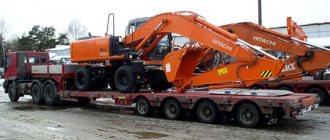Rail transportation is one of the most optimal options for transporting machinery and equipment belonging to the category of “heavy cargo”. This is due to the maximum degree of safety, an extensive network of roads, lack of dependence on weather conditions, regularity of traffic at a low cost of transportation. As a rule, heavy cargo is also oversized. It is in the field of transportation of such machinery and equipment that the company has accumulated solid experience, allowing it to correctly and quickly draw up documentation, load and deliver machinery, equipment or products to the right place.
Motor transport
In road transport, heavy cargo is understood as cargo that, during transportation, creates a load that exceeds the established standards in terms of each axle of the vehicle (in this case, the weight of the cargo and the weight of the vehicle are summed up).
Road transport in the CIS
Permissible loads for trucks during transportation between CIS countries (Agreement on the masses and dimensions of vehicles carrying out interstate transportation on the roads of the CIS member states of 1999):
| Vehicle type | Number of axes | Maximum permissible load (vehicle + cargo), tons |
| Single cargo vehicles | 2 | 18 |
| 3 | 24 (25 for cars with air suspension) | |
| 4 | 32 | |
| 5 | 35 | |
| Road trains / tractor units with trailers | 3 | 28 |
| 4 | 36 (40 with axle distances greater than 1.8 m) | |
| 5 | 40 | |
| 6 | 44 | |
| Buses | 2 | 18 |
| 3 | 24 (28 for articulated axles) | |
| 4 | 28 |
When transporting cargo within the Russian Federation, carriers must be guided by the “Rules for the transportation of goods by motor transport”, approved by Decree of the Government of the Russian Federation No. 272 (from 2011 with current amendments), which establish the maximum weight of the entire vehicle (including cargo) and the maximum axle load.
Maximum vehicle weight in the Russian Federation
The indicated parameters in Appendix 1 to the Rules of Transportation:
| Vehicle type | Number of axes | Maximum permissible weight (vehicle + cargo), tons |
| Single cargo vehicles | 2 | 18 |
| 3 | 25 | |
| 4 | 32 | |
| 5 or more | 38 | |
| Road trains / tractor units with trailers | 3 | 28 |
| 4 | 36 | |
| 5 | 40 | |
| 6 or more | 44 |
When compared with the Agreement of the CIS countries, it is clear that the differences are insignificant.
Maximum permissible axle load in the Russian Federation
According to Appendix 2 to the Rules for Transportation by Motor Transport:
| Axes location | Axle distance | Maximum load on one axle depending on the standard road load | ||
| For a road designed for a load of 6 t (single wheels/dual wheels) | For a road designed for a load of 10 tf (single wheels/dual wheels) | For a road designed for a load of 11.5 t (single wheels/dual wheels) | ||
| Single axis | More than 2.5 m | 5,5 / 6 | 9 / 10 | 10,5 / 11,5 |
| Twin axles | No more than 1 m | 8 / 9 | 10 / 11 | 11,5 /12,5 |
| From 1 to 1.3 m | 9 / 10 | 13 / 14 | 14 / 16 | |
| From 1.3 to 1.8 m | 10 / 11 | 15 / 16 | 17 / 18 | |
| From 1.8 to 2.5 m (hereinafter considered as a single axle) | 11 / 12 | 17 / 18 | 18 / 20 | |
| Triple axles | No more than 1 m | 11 / 12 | 15 / 16,5 | 17 / 18 |
| From 1 to 1.3 m | 12 / 13 | 18 / 19,5 | 20 / 21 | |
| From 1.3 to 1.8 m | 13,5 / 15 | 21 / 22,5 | 23,5 / 24 | |
| From 1.8 to 2.5 m (hereinafter considered as a single axle) | 15 / 16 | 22 / 23 | 25 / 26 | |
| More than three close axes in a group | No more than 1 m | 3,5 / 4 | 5 / 5,5 | 5,5 / 6 |
| From 1 to 1.3 m | 4 / 4,5 | 6 / 6,5 | 6,5 / 7 | |
| From 1.3 to 1.8 m | 4,5 / 5 | 6,5 / 7 | 7,5 / 8 | |
| From 1.8 to 2.5 m (hereinafter considered as a single axle) | 5 / 5,5 | 7 / 7,5 | 8,5 / 9 | |
| For closely spaced axles equipped with 4 or more single or double wheels on each axle (for groups of 2 or more axles) | No more than 1 m | 6 / 6,5 | 9,5 / 10 | 11 / 11,5 |
| From 1 to 1.3 m | 6,5 / 7 | 10,5 / 11 | 12 / 12,5 | |
| From 1.3 to 1.8 m | 7,5 / 8 | 12 / 12,5 | 14 / 14,5 | |
| From 1.8 to 2.5 m (hereinafter considered as a single axle) | 8,5 / 9 | 13,5 / 14 | 16 / 16,5 | |
During control weighing, a two percent error is allowed (clause 4 of Article 31 257-FZ of 2007 in the current edition), further excess without permits is a fine.
Regional authorities have the right to establish seasonal restrictions for maximum permissible standards within the constituent entities of the Russian Federation on individual routes or sections thereof.
Heavy cargo during groupage transportation
In some cases, the carrier of groupage cargo may ask for an additional fee for exceeding weight standards. Let's consider the situation using the example of a standard 20-ton truck:
- The maximum permissible design load for this type of transport is about 20-22 tons of cargo (so that, taking into account its own weight of 14 tons, the truck can fit into the standard for the maximum permissible weight - 36 tons for a 4-axle vehicle).
- The capacity of the truck is 33 standard Euro pallets.
- 20 tons / 33 pallets ≈ 600 kg (must be on 1 pallet).
If the specified weight standard for one pallet/pallet is exceeded, the carrier will have to reduce the number of transported pallets in order to pass weight control. And this is a reason to increase the cost of one piece of cargo to compensate for the cost of all reductions.
Special permits for the transportation of heavy cargo
Moving vehicles whose weight and axle load exceed the established standards is prohibited without special permits.
Permissions can be:
- interregional (when the route passes through 2 or more regions of the Russian Federation);
- international (when traveling outside the Russian Federation);
- local (within one region).
Registration is possible in several ways:
- online (via the State Services portal);
- in person (in Uprdor branches);
- through a representative (with a properly executed power of attorney).
To analyze and approve travel along a given route with heavy cargo, you must provide the following package of documents:
- statement;
- cargo drawings and specifications (at least the weight and dimensions of all cargo items);
- loading and unloading areas;
- route/traffic routes (main and, if possible, alternative).
Based on the results of the application, permission or refusal will be issued.
The costs of transporting heavy cargo will consist of the following components:
- state fee for obtaining a permit;
- damage to road surfaces (calculated individually based on the quality of roads on the chosen route);
- expenses for cargo escort;
- direct transportation costs.
For driving along routes not indicated in the permit, as well as for violating other regulations, penalties will be imposed on the carrier.
Selection of lifting devices
When moving a load, load-handling device or container horizontally, it should first be lifted 500 mm above equipment, building structures and other objects encountered along the way.
| < Lifting devices and containers | Content | Studying the standard slinger instructions > |
4.8 5 votes
Article rating
Shipping
Heavy cargo when transported by sea means shipments whose weight exceeds 35 tons.
Separately, there are unique large-sized heavy cargo (UKTG) - these are oversized cargo, the weight of which exceeds 100 tons.
Basis - Safety rules for sea transportation of large and heavy cargo (KTG) - RD 31.11.21.24-96 (put into effect by Rosmorflot Order No. 44 of 1996).
Transportation of heavy cargo is impossible without drawing up a project.
The project executor may be a carrier company or another competent organization (for example, a research institute). The project is calculated based on the technical specifications of the customer/client.
The project should indicate:
- optimal transportation option;
- load securing diagrams with calculations;
- calculations concerning the vessel (ballasting, strength, stability, etc.);
- other calculations in case of retrofitting of the vessel (for example, when reinforcing decks);
- organization of loading and unloading, including weather conditions;
- a detailed list of auxiliary materials and mechanization equipment;
- instructions to the captain;
- measures to prepare berths (only if necessary).
The project is coordinated with the Maritime Register of Shipping.
Project organizations may supervise the procedures for loading, unloading, securing and transporting cargo in accordance with the project.
What does the slinger need to know about the load?
To lift a load, its mass, center of gravity and slinging pattern must be known.
The mass of the load can be determined using the formulas:
- for simple loads - Q = m V;
- for complex loads - Q = m ∑Vi,
where Q is the mass of the cargo, m is the specific mass (numerically equal to the density) of the material, V is the volume of the cargo, ∑Vi is the sum of all parts of the cargo volume.
The specific gravity of commonly encountered materials is given in the table.
Specific gravity of materials
| Materials | Specific gravity, kg/m3 | Materials | Specific gravity, kg/m3 |
| Concrete | 2200 | Sandstone | 2200-2500 |
| Water | 1000 | Coke | 450 |
| Ice | 900 | Steel: | |
| Wood: | - hard | 7300 | |
| - birch | 700 | - melt | 7500 |
| - oak | 800 | Coal | 900 |
| - pine | 500 | Cast iron: | |
| Earth clay | 1300-2500 | white | 7650 |
| Sand: | malleable | 7300 | |
| - dry | 1400-1600 | grey | 7550 |
| - wet | 1900-2000 | Petrol | 700 |
How should a slinger act if the mass of the load is unknown?
The slinger is prohibited from slinging loads whose mass is unknown. In this case, the slinger must notify the person responsible for the safe performance of work with cranes and obtain from him information about the weight of the load.
What is the center of gravity of a load? Where it is located?
The center of gravity of a load is the point relative to which the load is balanced in all directions.
The center of gravity of simple-shaped loads (cube, parallelepiped, cylinder, ball) is located in their geometric center. The position of the center of gravity of the load must be indicated by a handling sign if it is shifted relative to the geometric center of the load. In this case, the location for slinging the load can also be indicated with a handling sign (Figure 2.1).
Figure 2.1 - Using a manipulation sign
How to perform slinging taking into account the location of the load’s center of gravity?
A load that is strapped without taking into account the location of the center of gravity may end up in an unstable position.
The load will be stable if its center of gravity is located between the slinging points. It is permissible to tie the load with one sling at the location of the center of gravity if the length of the load is no more than 2 m.
What kind of slinging parts can loads have?
Hooking loads with branch slings is a simpler and safer method than tying. For hooking, loads can have loops, eye bolts (Figure 2.2), holes, axles (a axle is the bearing or supporting part of an axle or shaft).
Figure 2.2 - Eye bolt
What do manipulation and danger signs indicate?
Handling signs indicate the method of handling the cargo. They are applied to packaging, containers or directly to cargo. Figure 2.3 shows some of the handling signs that the slinger needs to know.
Figure 2.3 - Manipulation signs
Danger signs are applied to goods that, during transportation and loading and unloading operations, can cause harm to people and the environment. The danger sign is a square mounted on an edge, in which a symbol is depicted indicating the type of danger (explosion hazard, fire hazard, toxicity, radioactivity, etc.).
Before performing loading and unloading operations with dangerous goods, the slinger must be instructed.
Figure 2.4 shows what danger signs look like.
Figure 2.4 - Danger signs
Aviation transport
Heavy cargo during air transportation includes cargo whose weight exceeds 80 kg.
Basis - Guidelines for freight transportation on domestic routes (RGP-85), paragraph 2.9.1.
If the specified standard is exceeded, the customer will require separate approval of the route for transportation. This is due to the fact that not all airports can handle cargo handling for heavy items.
For example, individual airports may handle the following cargo without additional approval:
| Airport city | Acceptable weight of the item (no approval required) |
| Barnaul | Up to 200 kg |
| Astrakhan | Up to 150 kg |
| Volgograd | Up to 100 kg |
| Vladikavkaz | Standard standard (up to 80 kg) |
| Krasnodar | Up to 200 kg |
| Omsk | Up to 100 kg |
| Stavropol | Up to 250 kg |
| Ufa | Up to 150 kg |
By separate agreement, individual conditions and transportation route will be determined, as well as the procedure and conditions of loading and unloading operations.
Transportation will require a separate package of accompanying and permitting documents.
How should large and heavy cargo be stowed?
Based on labor protection requirements, there are several conditions related to the issues of stacking oversized items:
- Heavy and large items should be placed in one row on special linings.
- Items to be transported further are stacked in such a way that the placed items do not fall, fall apart, or tip over. At the same time, it is necessary to ensure easy access to loaded items and safe unloading.
- Load placed on transport near ground crane and railway tracks should be placed no closer than 2 meters from the outer part of the nearest rail if the stack height is up to 1.2 m. For large stack parameters - no less than 2.5 meters.
Our advantages
- Speed . Our own fleet of vehicles, developed schemes, established coordination mechanisms, all this allows us to deliver cargo from point “A” to point “B” with minimal time costs.
- Safety . provides a guarantee of cargo safety from the moment of rigging until its transfer at the destination. We bear full legal and financial responsibility, and additionally provide the opportunity to insure all possible risks.
- Benefit . We approach each customer individually, providing the most attractive conditions when placing a large order and for regular customers.
- Reliability . We not only guarantee the safety of transportation of large, heavy and dangerous goods, but also provide information about its current condition and location to the client.
- Versatility . We work with all types of cargo, which allows us to satisfy all the needs of our clients.
We approach each project comprehensively, which saves our clients time and money.
What dimensions are allowed for transportation by truck?
If you plan to transport cargo by truck, then the following dimensions must be taken into account:
- together with the car, the height of the load should not exceed 4 meters;
- width: for all types of vehicles - 2.55 meters;
- length – 20 meters.
Objects protruding beyond the dimensions of the truck, at the rear and in front by more than 1.0 m, and on the side by more than 0.4 m from the edge, must be marked with “Large cargo” identification marks. For dark times of the day and in case of insufficient visibility - a flashlight in front and behind or a reflector.
Conclusion
Any traffic on roads is associated with certain risks both for drivers and for the safety of transported cargo. This is especially true for oversized items. All legal requirements must be strictly followed, then the risks will be reduced.
What should you pay special attention to?
As you can see, only a small fraction of the aspects of transporting oversized goods are covered by the Road Traffic Regulations. Basic regulation of the transportation of oversized cargo on the roads of the Russian Federation is carried out by Federal Law No. 257-FZ.
The criteria depend on what kind of transport you use. Below are the cargo parameters in the case of road transport.
In addition, the law makes changes to the “favorite” article of the Code of Administrative Offenses for oversize trucks - 12.21.1.
The criteria depend on what kind of transport you use. Below are the cargo parameters in the case of road transport.
In addition, the law makes changes to the “favorite” article of the Code of Administrative Offenses for oversize trucks - 12.21.1.
Dangerous goods are the most famous group of goods. This includes substances or objects that, if transported incorrectly, can harm the environment and human health, as well as damage property. Not every driver can transport dangerous goods - for this you need to obtain a license or a special permit.







